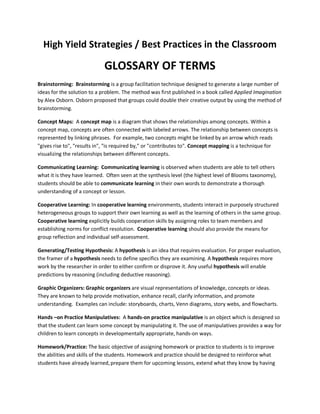High Yield Strategies Glossary For 360 Teacher Training
- 1. ĪŠĺĪ≤Ķ≥ůŐż≥ŘĺĪĪūĪŰĽŚŐż≥ß≥Ŕįý≤Ļ≥ŔĪū≤ĶĺĪĪū≤űŐż/ŐżĶĢĪū≤ű≥ŔŐżĪ įý≤Ļ≥¶≥ŔĺĪ≥¶Īū≤űŐżĺĪ≤‘Őż≥Ŕ≥ůĪūŐżįšĪŰ≤Ļ≤ű≤űįýī«ī«≥ĺŐż GLOSSARY¬†OF¬†TERMS¬† Brainstorming:¬† Brainstorming is¬†a¬†group¬†facilitation¬†technique¬†designed¬†to¬†generate¬†a¬†large¬†number¬†of¬† ideas¬†for¬†the¬†solution¬†to¬†a problem.¬†The¬†method¬†was¬†first¬†published¬†in¬†a¬†book¬†called Applied¬†Imagination¬† by¬†Alex¬†Osborn. Osborn¬†proposed¬†that¬†groups¬†could¬†double¬†their¬†creative¬†output¬†by¬†using¬†the¬†method¬†of¬† brainstorming.¬† Concept¬†Maps:¬† A concept¬†map is¬†a¬†diagram¬†that¬†shows¬†the relationships¬†among¬†concepts.¬†Within¬†a¬† concept¬†map,¬†concepts¬†are often¬†connected¬†with¬†labeled¬†arrows.¬†The¬†relationship¬†between¬†concepts¬†is¬† represented¬†by¬†linking¬†phrases.¬†¬†For¬†example,¬†two¬†concepts¬†might¬†be¬†linked¬†by¬†an¬†arrow¬†which¬†reads¬† quot;gives¬†rise¬†toquot;,¬†quot;results¬†inquot;, quot;is¬†required¬†by,quot;¬†or¬†quot;contributes¬†toquot;. Concept¬†mapping is¬†a¬†technique¬†for¬† visualizing the¬†relationships between different concepts.¬† Communicating¬†Learning:¬† Communicating¬†learning is¬†observed¬†when¬†students¬†are¬†able¬†to¬†tell¬†others¬† what¬†it¬†is¬†they¬†have¬†learned.¬†¬†Often¬†seen¬†at¬†the¬†synthesis¬†level¬†(the¬†highest¬†level¬†of¬†Blooms¬†taxonomy),¬† students¬†should¬†be¬†able¬†to communicate¬†learning in¬†their¬†own¬†words¬†to¬†demonstrate¬†a¬†thorough¬† understanding¬†of¬†a¬†concept¬†or¬†lesson.¬† Cooperative¬†Learning: In cooperative¬†learning environments,¬†students¬†interact¬†in¬†purposely¬†structured¬† heterogeneous groups¬†to¬†support¬†their¬†own¬†learning¬†as¬†well¬†as¬†the¬†learning¬†of¬†others¬†in¬†the¬†same¬†group.¬† Cooperative¬†learning explicitly¬†builds¬†cooperation¬†skills¬†by¬†assigning¬†roles¬†to¬†team¬†members¬†and¬† establishing¬†norms¬†for¬†conflict¬†resolution.¬† Cooperative¬†learning should¬†also¬†provide¬†the¬†means¬†for¬† group¬†reflection¬†and¬†individual¬†self‚Äźassessment.¬† Generating/Testing¬†Hypothesis: A hypothesis is an¬†idea that requires¬†evaluation.¬†For¬†proper¬†evaluation,¬† the¬†framer¬†of¬†a hypothesis needs¬†to¬†define¬†specifics they¬†are¬†examining.¬†A hypothesis requires¬†more¬† work¬†by¬†the¬†researcher¬†in¬†order¬†to¬†either¬†confirm¬†or¬†disprove¬†it. Any¬†useful hypothesis will¬†enable¬† predictions by reasoning (including deductive¬†reasoning).¬† Graphic¬†Organizers:¬†Graphic¬†organizers are¬†visual¬†representations¬†of¬†knowledge,¬†concepts¬†or¬†ideas.¬† They¬†are¬†known¬†to¬†help¬†provide¬†motivation,¬†enhance¬†recall,¬†clarify¬†information,¬†and¬†promote¬† understanding.¬†¬†Examples¬†can include:¬†storyboards,¬†charts,¬†Venn diagrams,¬†story¬†webs,¬†and¬†flowcharts.¬† Hands ‚Äďon Practice¬†Manipulatives:¬† A hands‚Äźon practice¬†manipulative is¬†an¬†object¬†which¬†is¬†designed¬†so¬† that¬†the¬†student¬†can¬†learn¬†some¬†concept¬†by¬†manipulating¬†it.¬†The¬†use¬†of¬†manipulatives¬†provides¬†a¬†way¬†for¬† children¬†to learn¬†concepts¬†in¬†developmentally¬†appropriate,¬†hands‚Äźon¬†ways.¬† Homework/Practice: The¬†basic¬†objective¬†of¬†assigning¬†homework¬†or¬†practice¬†to¬†students¬†is¬†to¬†improve¬† the¬†abilities¬†and¬†skills¬†of¬†the¬†students.¬†Homework¬†and¬†practice¬†should¬†be¬†designed¬†to reinforce¬†what¬† students¬†have¬†already¬†learned, prepare¬†them¬†for¬†upcoming¬†lessons,¬†extend¬†what¬†they¬†know¬†by¬†having
- 2. them¬†apply¬†it¬†to¬†new¬†situations,¬†or¬†integrate¬†their¬†abilities¬†by¬†applying¬†many¬†different¬†skills¬†to¬†a¬†single¬† task.¬† Identifying¬†Similarities/Differences:¬† Identifying¬†similarities¬†and¬†differences have¬†been¬†identified¬†as¬† foundational¬†to¬†human¬†thought,¬†the¬†core¬†of¬†all¬†learning.¬† When¬†a¬†learner¬†is¬†introduced¬†to¬†a¬†concept,¬† prior¬†knowledge¬†is¬†activated.¬†¬†There¬†are¬†four¬†key¬†ways¬†to identify¬†similarities¬†and¬†differences:¬†compare;¬† classify;¬†create¬†metaphors¬†(An¬†apple¬†is¬†like¬†a¬†banana¬†because),¬†and¬†create¬†analogies¬†(inches¬†are¬†to¬†feet¬† as¬†ounces¬†are¬†to¬†cups).¬† KWL:¬†KWL is¬†a graphical¬†organizer designed¬†to¬†help¬†in learning.¬†The¬†letters KWL are¬†an acronym for¬† quot;what¬†we knowquot;,¬†what¬†we want¬†to¬†know,¬†and¬†quot;what¬†we learnedquot;.¬†A KWL table¬†is¬†typically¬†divided¬†into¬† three¬†columns.¬†¬†The¬†first¬†two¬†columns,¬†‚ÄúWhat¬†we¬†know,‚Ä̬†and¬†‚ÄúWhat¬†we¬†want¬†to¬†know‚Ä̬†can¬†be¬† completed¬†by¬†a¬†class¬†at¬†the¬†beginning¬†of¬†a¬†lesson¬†cycle.¬†¬†The¬†final¬†column,¬†‚ÄúWhat¬†we¬†learned,‚Ä̬†would¬†be¬† completed¬†at¬†the¬†end¬†of¬†a¬†lesson.¬† Nonlinguistic¬†Representations:¬†Nonlinguistic¬†representations refer¬†to¬†all¬†descriptions¬†evoked¬†without¬† using¬†words.¬† By¬†invoking¬†imagery,¬†teachers¬†can¬†assist¬†learners¬†in¬†creating¬†meanings¬†that¬†are¬†more¬†fully¬† developed¬†than¬†learning¬†created¬†only¬†through¬†words.¬†¬†Examples¬†of¬†nonlinguistic¬†representations¬†include:¬† creating¬†graphic¬†representations;¬†making¬†physical¬†models;¬†generating¬†mental¬†pictures;¬†drawing¬†pictures;¬† and¬†engaging¬†in¬†kinesthetic¬†activity.¬† Projects,¬†Demonstrations,¬†Modeling,¬†Labs: One¬†of¬†the¬†keys¬†to¬†student¬†engagement¬†is involving students¬† the¬†doing¬†of the work.¬†¬†By engaging students¬†in projects,¬†demonstrations,¬†modeling,¬†and¬†labs,¬†students¬† are¬†able¬†to¬†interact¬†with¬†their¬†own¬†learning.¬†¬†As¬†an¬†additional¬†benefit,¬†students¬†whose¬†primary¬†learning¬† style¬†is¬†not¬†auditory¬†will¬†be¬†more¬†likely¬†to¬†interact¬†with¬†and¬†recall meaning,¬† which¬†they¬†helped to¬†create.¬† Reinforcing¬†Effort/Providing¬†Recognition:¬† Not¬†all¬†students¬†believe¬†that¬†their¬†effort¬†plays¬†a¬†direct¬†role¬†in¬† their¬†achievement.¬†¬†They¬†may¬†instead¬†believe¬†their¬†grades¬†are¬†a¬†reflection¬†of¬†raw¬†intelligence.¬†¬†By¬† explaining¬†to¬†students¬†the¬†importance¬†of¬†effort,¬†and¬†reinforcing¬†that¬†effort¬†from¬†students,¬†teachers¬†can¬† directly¬†impact¬†student¬†achievement.¬† An example¬†of reinforcing¬†effort would¬†be¬†to¬†ask¬†students¬†to¬†rate¬† themselves¬†on¬†a¬†1‚Äź5¬†Likert¬†Scale¬†as¬†to¬†how¬†much¬†effort¬†they¬†put¬†into¬†a¬†given¬†task.¬† Providing¬†recognition¬† to¬†students¬†in¬†the¬†form¬†of¬†effective¬†praise¬†has¬†been¬†shown¬†to¬†be¬†even¬†more¬†effective¬†than¬†providing¬† tangible¬†rewards.¬†¬†Some¬†of¬†the¬†characteristics¬†of¬†effective¬†recognition¬†is¬†that¬†it¬†is¬†specific,¬†it¬† communicates¬†the¬†value¬†of¬†the¬†student‚Äôs¬†work, and it¬†attributes¬†success¬†to¬†the¬†effort¬†the¬†student¬†put¬† into¬†the¬†work.¬† Setting¬†Objectives/Providing¬†Feedback:¬† The objective¬†sets the¬†direction¬†for¬†learning.¬†¬†When teachers¬† clearly¬†explain where¬†the¬†learning¬†is¬†headed,¬†they¬†are¬†more¬†likely¬†to help¬†students¬†understand¬†and¬† retain¬†both¬†short and¬†long‚Äźterm¬†learning¬†goals.¬† Providing¬†feedback helps¬†learners¬†to¬†understand¬†their¬† progress¬†in¬†mastering¬†learning¬†objectives.¬†¬†Research¬†has¬†shown¬†that¬†in¬†order¬†for¬†feedback¬†to be¬† meaningful,¬†it¬†must¬†be¬†corrective,¬†timely,¬†and¬†specific.¬†¬†Ideally,¬†students¬†should¬†be¬†included in¬†this¬† process as¬†they¬†self‚Äźassess¬†their¬†own¬†work¬†in¬†addition¬†to receiving teacher¬†feedback.
- 3. Small Group Instruction: The use of small group instruction is widely acknowledged as an effective  method to activate student interest and promote collaboration.  Small group instruction differs from  cooperative learning in that small group instruction involves the teacher working directly with a small  group of students to remediate, instruct, or extend student learning.  Solving Problems (Multiple Ways): Problems and solutions can be approached in multiple ways:  Symbolically, graphically, numerically, verbally, etc.  By providing students with multiple solution  strategies, teachers provide learners with choices which the students can then apply to their own  learning.  Allowing students to represent problems and solutions in ways which are meaningful to them  enhances their interaction with the problem.  Step Vocabulary Process: Instead of giving students a list of words to memorize, the step vocabulary  method introduces academic terms in a multi­step process.  For example, in identifying the new word,  the teacher might ask students what they might already know about the word.  Later, the teacher will  explain the meaning of the word.  Students may be given the opportunity to generate their own  explanation of the word, and/or graphically represent the word.  Finally, students can play games or  engage in activities that help crystallize their understanding and memory of the word.  Story Mapping: Story maps are visual representations of the parts of a story.  While story maps differ  in content, most will include common factors, such as the setting, the characters, the problem, the  plot and the conclusion. Story maps help students to visualize the story and organize their thoughts as  a first step in the writing process.  Summarizing/Note Taking:  In order to effectively summarize, students need to be able to delete trivial  or redundant material; create categories to group subordinate terms, and create topic sentences.  A  compliment to summarizing is the skill of note taking.  One of the more common uses for note taking is  to utilize notes in studying for exams.  To maximize this usefulness, notes should be viewed as a work in  progress, continuously reviewed and revised throughout the lesson cycle.  Wait Time: Allowing learners time to interact and respond to a concept can be a crucial part of a  student’s learning.  While there may be some disagreement on how much time is too long or too short  to wait for student responses, practitioners agree that too much or too little wait time can diminish  student interaction with a lesson.  Word Walls: A word wall is literacy tool composed of an organized collection of words which are  displayed in large visible letters on a wall, bulletin board, or other display surface in a classroom. The  word wall is designed to be a tool for students to use, not just a display, and contains a list of words that  can be used to reinforce vocabulary.  Portions of the definitions above were drawn from Wikipedia.org; Classroom Instruction that Works,  by Robert Marzano et al., and Building Academic Vocabulary, by Robert Marzano et al.


